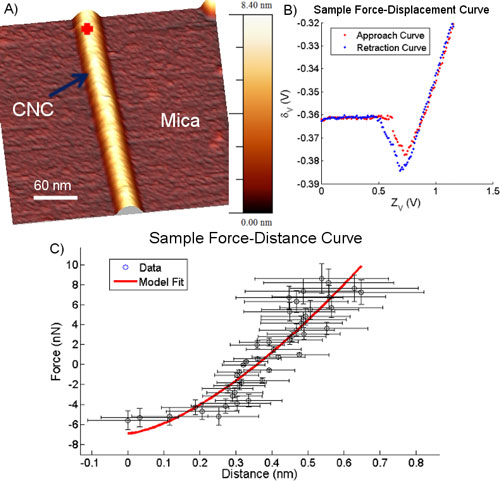| Posted: Nov 11, 2011 | |
A framework to evaluate the uncertainties of AFM nanomechanical measurements |
|
| (Nanowerk Spotlight) Standards, in a scientific context, have a much larger role in our society than just agreeing measurements. As the British Standards Institution (BSI) explains it, put at its simplest, a standard is an agreed, repeatable way of doing something. It is a published document that contains a technical specification or other precise criteria designed to be used consistently as a rule, guideline, or definition. | |
| A couple of years ago, we wrote about the role of standards in nanotechnology. While this was a general observation, today we'll look at a very specific example of the need for standards in one of the key enabling areas of nanotechnologies: atomic force microscopy (AFM). | |
| Uncertainty evaluation is an often overlooked factor in many AFM material property measurement work – nevertheless it is critical for obtaining truly quantitative measurements. | |
| "The atomic force microscope is used extensively for measuring the material properties of nanomaterials with nanometer resolution, unfortunately there is a lack of standards and uncertainty quantification in these measurements," explain Robert Moon, an Adjunct Assistant Professor of Materials Engineering, and Arvind Raman Professor of Mechanical Engineering, both at Purdue University. "Other fields, such as six sigma standards in industry and beam corrections in scanning electron microscopy, have developed thorough methods for quantifying the uncertainty in a given measurement, model, or system. Broadly speaking these methods can be classified as uncertainty quantification. Without applying the methods of uncertainty quantification to AFM measurements it is impossible to say if the measurements are accurate within 5% or 100%." | |
| Moon and Raman at Purdue's Birck Nanotechnology Center and collaborators at the National Institute of Standards and Technology (NIST) including Drs. Jon Pratt and Gordon Shaw, have now presented a framework to ascribe uncertainty to local nanomechanical properties of any nanoparticle or surface measured with the AFM by taking into account the main uncertainty sources inherent in such measurements. | |
| In a recent paper in the October 13, 2011 online edition of Nanotechnology ("Uncertainty quantification in nanomechanical measurements using the atomic force microscope"), the team demonstrates their framework by quantifying uncertainty in AFM-based measurements of the transverse elastic modulus of cellulose nanocrystals, an abundant, plant-derived nanomaterial whose mechanical properties are comparable to Kevlar fibers. | |
 |
|
| A) Topography image of Tunicate cellulose nanocrystals deposited on mica. The cross shows location where a sample force-displacement curve was extracted. (B) One sample force-displacement curve extracted from the top of the cellulose nanocrystals. (C) One sample force-distance curve with 95% confidence interval shown for each data point on the curve. (Reprinted with permission from IOP Publishing) | |
| "Our findings demonstrate the inherently large uncertainty associated with certain types of AFM material property measurements," Ryan Wagner, a graduate student in Raman's group at Purdue, and the paper's first author, tells Nanowerk. "Specifically, force-displacements measurements of elastic modulus on thin, stiff samples are very uncertainty because of poor indentation resolution. In addition, our work provides a general framework for evaluating uncertainty in force-displacement based elasticity measurements that is valid for all samples and AFMs." | |
| The research team was motivated to conduct this work in an effort to insure comparability between multiple sets of measurements of the elastic modulus of cellulose nanocrystals. Their concern was to insure that any variability they reported in their measurements was the result of changes in their sample and not inherent to the measurement technique they used. | |
| Basically, what the team did was to apply uncertainty analysis techniques to the measurement of elastic and adhesive properties of nanoscale materials with AFM. | |
| "Our work has solved the problem of evaluating uncertainty for force-displacement AFM based measurements of elastic modulus" says Wagner. "We have provided specific insights into which parameters dominate the uncertainty." | |
| The result is a framework that can be used by the AFM community to estimate uncertainties in sample properties – such as elastic modulus or work of adhesion – by careful consideration of calibration uncertainties, instrument uncertainties and model uncertainties. | |
| This work underscores the rather large uncertainty that is intrinsic to elastic modulus measurements of nanoparticles using the AFM. However, it also highlights the key quantity that instrument developers need to focus on in order to reduce the uncertainty in such measurements. | |
| The researchers hope to extend this uncertainty analysis to other types of AFM elasticity measurements and preform systematic studies on several different materials utilizing the measurement approaches discussed in this paper. | |
 By
Michael
Berger
– Michael is author of three books by the Royal Society of Chemistry:
Nano-Society: Pushing the Boundaries of Technology,
Nanotechnology: The Future is Tiny, and
Nanoengineering: The Skills and Tools Making Technology Invisible
Copyright ©
Nanowerk LLC
By
Michael
Berger
– Michael is author of three books by the Royal Society of Chemistry:
Nano-Society: Pushing the Boundaries of Technology,
Nanotechnology: The Future is Tiny, and
Nanoengineering: The Skills and Tools Making Technology Invisible
Copyright ©
Nanowerk LLC
|
|
|
Become a Spotlight guest author! Join our large and growing group of guest contributors. Have you just published a scientific paper or have other exciting developments to share with the nanotechnology community? Here is how to publish on nanowerk.com. |
|
